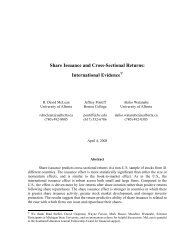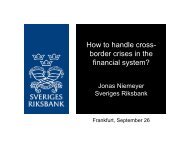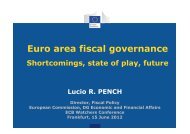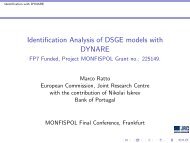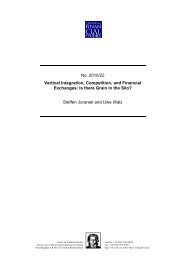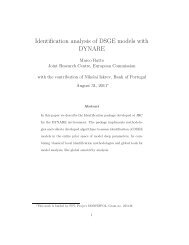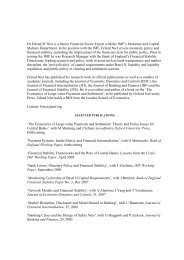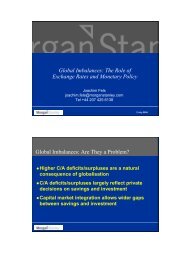Forecasting and Policy Making (Paper) - Center for Financial Studies
Forecasting and Policy Making (Paper) - Center for Financial Studies
Forecasting and Policy Making (Paper) - Center for Financial Studies
Create successful ePaper yourself
Turn your PDF publications into a flip-book with our unique Google optimized e-Paper software.
publication of the <strong>for</strong>ecasts in the ECB’s monthly bulletin.<br />
With regard to conditioning assumptions, national central bank staff <strong>and</strong> ECB staff decide on a<br />
joint set of exogenous time paths <strong>for</strong> interest rates, exchange rates, the international environment <strong>and</strong><br />
fiscal variables. The projections are based on ”the technical assumption that three-month interest rates<br />
in the euro area remain constant at the currently prevailing level over the horizon of the projection.<br />
This assumption is made in order to illustrate the possible consequences of leaving monetary policy<br />
unchanged over the projection horizon.” 8<br />
Afterwards each national central bank computes a <strong>for</strong>ecast <strong>for</strong> its country, whereas ECB staff pre-<br />
pare a set of projections <strong>for</strong> the individual countries as well as <strong>for</strong> the euro area as a whole. The ECB’s<br />
euro area projection is a consistent aggregation of its country assessments. The national central banks<br />
use a variety of models, econometric methods <strong>and</strong> sectoral or country expertise. The combination of<br />
model-based <strong>and</strong> judgemental-based in<strong>for</strong>mation may also vary across countries.<br />
Then an iterative process of consistency checking between the ECB’s area-wide <strong>for</strong>ecast <strong>and</strong> the<br />
aggregaton of the NCB <strong>for</strong>ecasts is started. This process relies on meetings of NCB <strong>and</strong> ECB experts,<br />
<strong>and</strong> importantly, also on analysis using the area-wide macroeconomic model of the ECB research<br />
directorate. 9 In addition, consistency checks are conducted with respect to trade volumes <strong>and</strong> prices<br />
as well as financial flows <strong>and</strong> consolidated balance sheets of monetary financial institutions in the euro<br />
area.<br />
The resulting euro system staff projections serve as an input about the current economic<br />
situation <strong>and</strong> the outlook <strong>for</strong> future economic developments to the ECBs Governing Councils<br />
meetings. The area-wide projections are published twice a year. The ECB’s staff publishes two<br />
additional sets of <strong>for</strong>ecasts to achieve a quarterly <strong>for</strong>ecasting frequency. Forecasts of variables<br />
that are published in the Monthly Bulletin include HICP inflation, real GDP growth <strong>and</strong> its main<br />
components over a two-year horizon. The projections are published in the <strong>for</strong>m of uncertainty ranges<br />
corresponding to 75% probability b<strong>and</strong>s. 10 Until 2008 this range has simply been equal to twice<br />
the average absolute <strong>for</strong>ecast error of past projections. Since 2008 Bayesian vector autoregression<br />
models are used to compute predictive densities that are then reshaped to be compatible with the<br />
euro system staff’s projections. From this density a range is derived that is comparable to the<br />
ranges computed with the simpler method until 2008 (see Robertson et al., 2005, <strong>for</strong> details of the<br />
methodology). Ranges are wider <strong>for</strong> longer <strong>for</strong>ecast horizons reflecting the increased uncertainty.<br />
The ranges reflect uncertainty due to un<strong>for</strong>eseeable shocks <strong>and</strong> imprecise parameter estimates as<br />
well as departures from the conditioning assumptions of the baseline <strong>for</strong>ecast. In addition specific<br />
scenarios deviating from the baseline conditioning assumptions are computed. For example, euro<br />
area system staff may compute a <strong>for</strong>ecast where the growth rate <strong>for</strong> the United States is assumed<br />
to be much lower than in the baseline case or where the oil price is assumed to be higher. Many<br />
8 See European Central Bank (2001), page 7.<br />
9 A description of the area-wide model is available in Fagan et al. (2005). In 2008 this model was replaced with a<br />
New-Area-Wide model that is presented in Christoffel et al. (2008).<br />
10 By contrast, the ranges of FOMC <strong>for</strong>ecasts published by the Federal Reserve indicate the level of disagreement between<br />
FOMC member point <strong>for</strong>ecasts rather than economic uncertainty b<strong>and</strong>s.<br />
10



